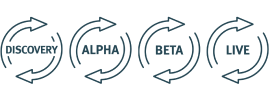Usability testing
The most effective way of understanding what works and what doesn’t in a digital product or service is to observe people using it. When the right participants attempt realistic activities, you gain qualitative insights into what is causing users to have trouble. These insights help you determine how to improve the design and functionality of your product or service.
When doing any type of usability testing, it is essential that the people you engage with are real users of your service or product. When you actively engage users linked to a service or product, you can build more effective solutions that target true user needs.
You might have heard of other ways to describe ’usability testing’. It can also be called ‘user experience (UX) testing’ or ‘usability testing’. However, it is not the same as ‘user acceptance testing (UAT)'.
Outcomes
- Evaluate the usability of your product or service
- Identify areas of improvement
- Verbatim notes ready for synthesis
Tip
It’s not a good idea to record user tests on your own device. You might capture personal information about the participant during the usability testing and there are strict rules about managing personal information on your device. It is best to avoid this.

The stages

The four stages of the Service design and delivery process are Discovery, Alpha, Beta, and Live.
Digital service standard
This play helps your service meet the following criteria of the digital service standard.
Share your feedback
Take our short feedback survey and tell us what you thought of this play, or report an issue.
This playbook is a beta product, your feedback helps us improve it for everyone.
Contact us
If you need advice, mentoring, or guidance on how to use the playbook, or you’d like to contribute to the playbook, you can contact us.